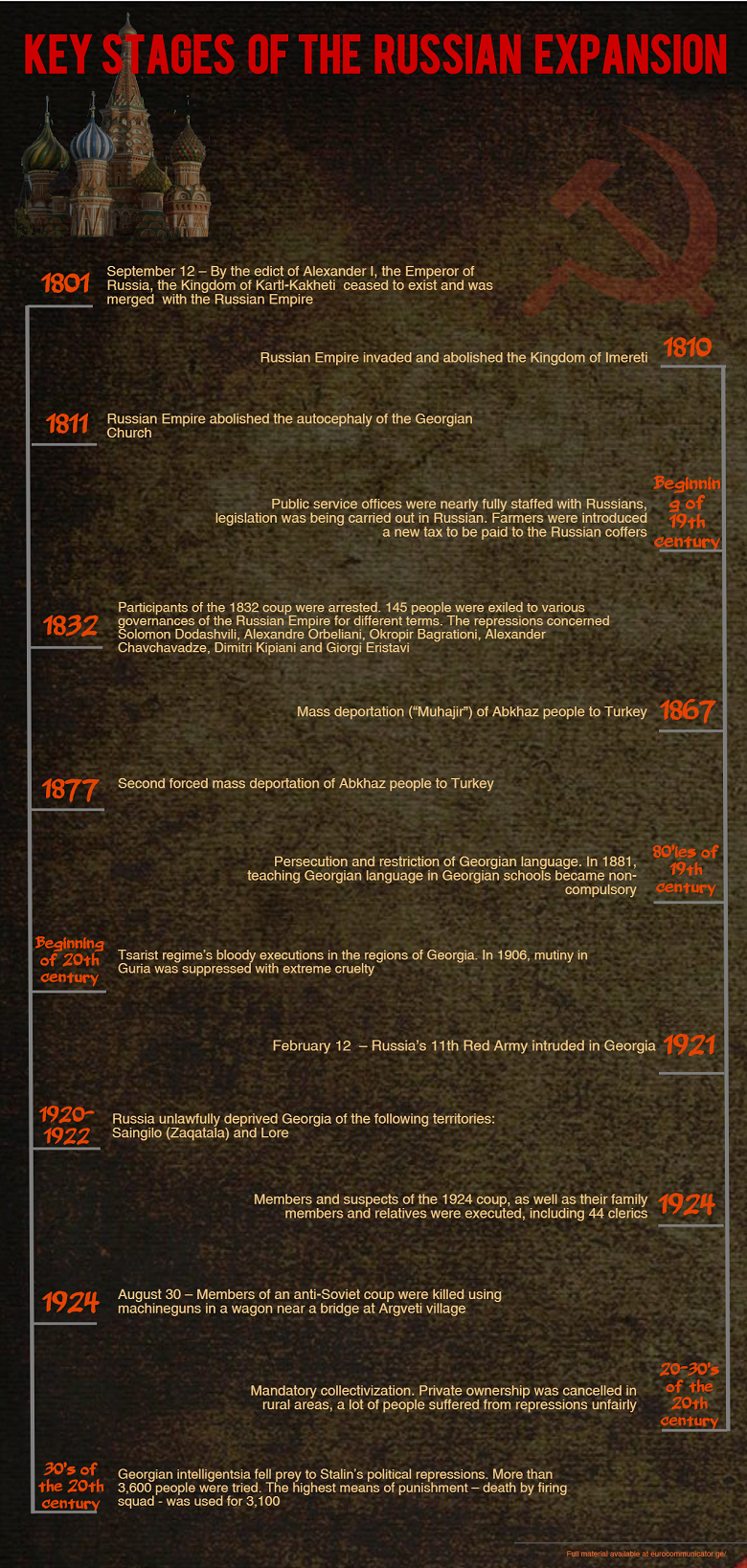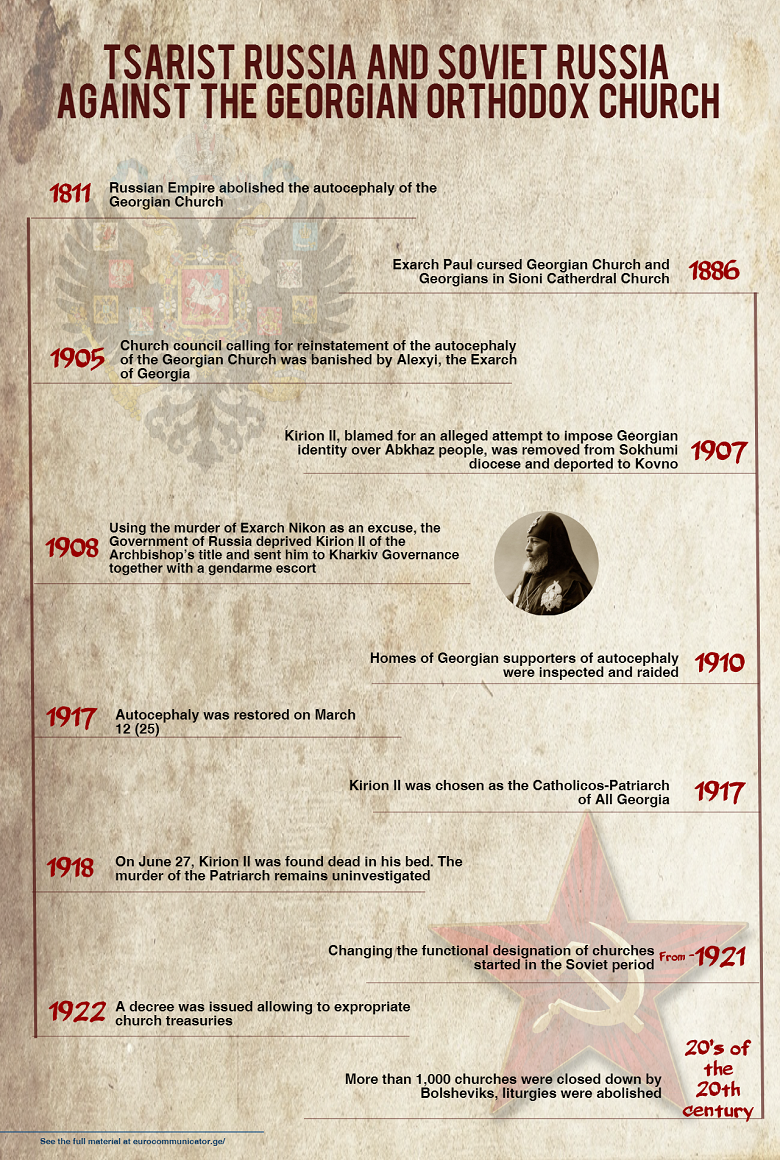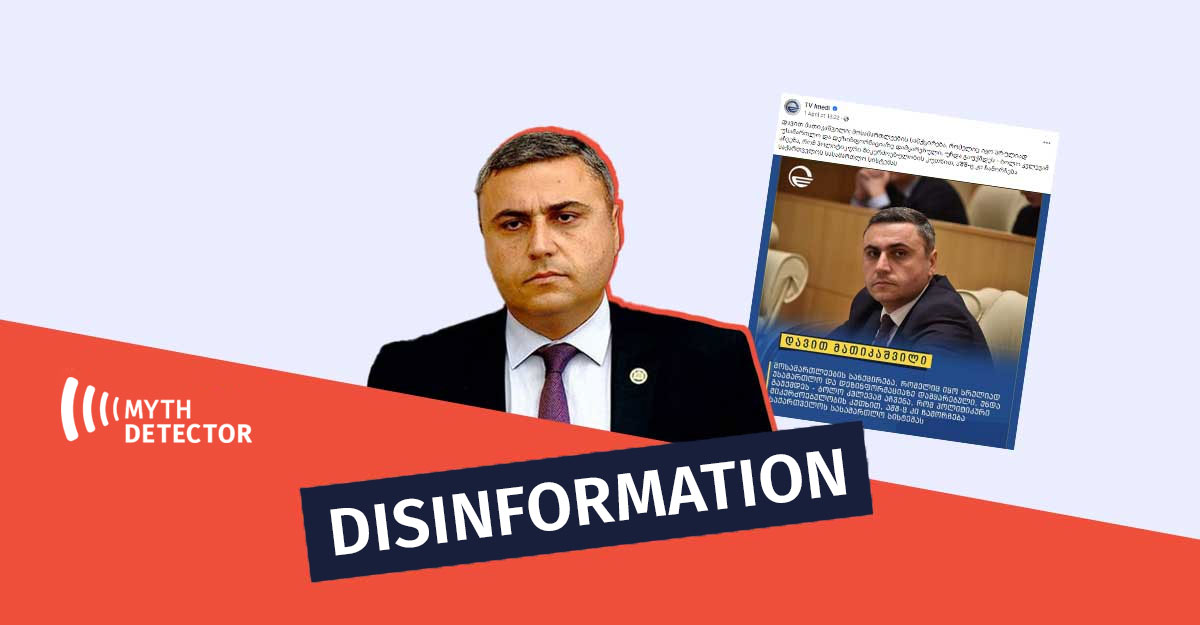Pro-Kremlin and Ethno-Nationalist media often cites Russia’s input in the development of Georgia as a counterbalance against the background of the integration of Georgia into the West. For instance, an Asaval-Dasavali journalist claims that Russia “opened a way” to Georgia, while the visa liberalization with the EU endangers the existence of Georgian identity.
Dito Chubinidze, journalist: “Indeed, from overall perspective, Georgians benefitted from the “opening” of road towards Russia not a long time ago, while the European visa liberalization, against the background of these traders being in the government, might cause the disappearance of Georgian identity!” Asaval-Dasavali, February 6-12
Myth Detector offers factual materials concerning the key stages of the Russian expansion in Georgia, including the Soviet occupation of 1921 political repressions and the colonial policy of Russia directed against Georgian Church.

- January 18, 1801: The manifesto issued by the Emperor Paul I on this day orders the abolition of the Kingdom of Kartl-Kakheti, however he fell prey to a conspiracy and could not witness the execution of his order. The manifesto was not announced in Tbilisi. On September 12, 1801, the manifesto issued by the successor of Paul I, Alexander I, abolished the Kingdom of Kartl-Kakheti and merged it with the Russian Empire. In 1810, Russian Empire invaded and abolished the Kingdom of Imereti. The word “Georgia” officially disappears.
- First half of the 19th century: From 1801, Russia started persecuting members of Bagrationi royal family and deporting them to Russia. Both Georgian feudal aristocracy and peasantry faced difficult reality, while a new tax was imposed on the latter, to be paid to the Russian treasury. Public service offices were nearly fully staffed with Russians, while legislation was being carried out in Russian.
- 1832: Members of the conspiracy that expressed vocal protests against Russification were arrested including Solomon Dodashvili, Alexander Orbeliani, Okropir Bagrationi, Alexander Chavchavadze, Dimitri Kipiani and Giorgi Eristavi. This year, 145 people went through the repressions; they were deported to various governances of the Russian Empire for different terms.
- Muhajir of Abkhazians: In 1867, the Government of Russia, under its colonial policy, carried out a mass deportation of Abkhazian people to Turkey. The second wave of forced mass deportations of Abkhazians came in 1877. Following the Muhajir, North-West and Central Abkhazia was nearly completely desolated.
- 80’s of the 19th century: Persecution and restriction of Georgian language. In 1881, teaching Georgian language in Georgian schools became non-compulsory.
- 1906 – the beginning of the 20th century: Tsarist regime carries out bloody executions in the regions of Georgia, especially in Guria. Peasants from Guria launched an armed resistance against the Russian Empire. In 1906, mutiny in Guria was suppressed with extreme cruelty, under the command of general Krylov.
Soviet Occupation: “A Red Flag Waves above Tbilisi.”
At the night between February 11 and 12, 1921, a “revolt”, branded by Soviet propaganda as “Revolt of Georgian Workers”, broke out in Russian villages of Borchalo uyezd. On February 12, military actions between Georgia and Russia took start and the 11th Red Army of Russia intruded to Georgia. On February 25, they conquered Tbilisi without having to fight. Sergo Orjonikidze notified Vladimir Lenin via telegram:
“A Red Flag Waves above Tbilisi, long live the Soviet government.”
Georgian junkers, young militaries aged 20-23, greatly confronted Russian 11th Army. Cadets of the Junker School were requesting to get engaged in the military actions since the day the war broke out.
- February 17: 560 fighters of the military school, of which 152 were junkers, were sent to protect an 8-km line between Tabakhmela and Kojori.
- February 19: Red Army units started offensive on the positions of junkers. The junkers were not letting the enemy to get to the trenches. Later, Russians took hold of Tsavkisi village, and, as a response, a platoon of 23 junkers launched a counter-attack on open field. Despite the intense fire opened by the Russians, none of the junkers tried to lie down. In a head-to-head fight, the 23 junkers managed to defeat a company of 100 Russian soldiers. Eight junkesr died in the battle. Daughter of a Georgian poet, Konstantine Makashvili, Maro Makashvili, who was a volunteer on the front line, died on February 19. The fallen junkers were buried in a wall of a military church together with Maro Makashvili.
- February 24: Russian forces attacked Tbilisi from all sides, including the junkers who were holding position in Tabakhmela. Their numbers shrank to 85 after the military actions of February 19. The junkers were fighting the Baku Red Cadets’ Regiment all day long and did not lose positions.
- For eight days, junkers were gaining victory in every battle against the Russian Army. They gave up positions only after the Red Army weakened Georgian forces on Soghanlughi and Lilo lines, subjecting Tbilisi to the danger of a siege. Due to this fact, general Kvinitadze ordered to evacuate the city and leave the positions. Junkers were the last to leave Tbilisi.
Soviet Policy and Political Repressions
- 1920-1922: Russia unlawfully deprived Georgia of the following territories: Saingilo (Zaqatala) and Lore.
- Political repressions started in Georgia from 1921, right after establishing the Soviet occupational regime. Members and suspects of the 1924 coup, as well as their family members and relatives were executed, including 44 clerics. Big bourgeoisie and landlords class was completely eliminated.
- August 30, 1924: Cheka (Russian Emergency Committee) distributed the members of the 1924 coup in six rail carriages for transportation to Tbilisi. So that the people trapped in the carriages would not suspect anything, they were given loaves of bread, one loaf per carriage. The prisoners from the first carriage were let off the carriage near the bridge in Argveti village, placed near a pit and were killed by death squad. Those left in the remaining carriages refused to step off and were killed in the carriages with machineguns.
- 20-30’s of the 20th century: Stalin introduced collective farms (“kolkhoz”) with the aim of eliminating private ownership in the rural areas and achieving social equality. This aimed to make the peasants’ properties collective. A wealthy layer of peasants (“kulaks”) suffered from this policy, ultimately undermining the agriculture. Production decreased and lots of people were unfairly subjected to repressions.
- 1937-1938: More than 3,600 people were tried following the decision of Stalin and other members of politburo. The highest means of punishment – death by firing squad – was used for 3,100 of them. The executions were being carried out in Tbilisi, Kutaisi, Batumi and Sokhumi. Georgian intelligentsia fell prey to Stalin’s political repressions in the 30’s. The names included Mikheil Javakhishvili, Evgeni Mikeladze, Sandro Akhmeteli, Titsian Tabidze, Vakhtang Kotetishvili, Paolo Iashvili. Tbilisi State University was in difficult situation. Ivane Javakhishvili was forced to leave the university, which he founded.
Tsarist and Soviet Russia Against Georgian Orthodox Church

- In 1811, Russian Empire abolished the autocephaly of the Georgian Orthodox Church. An Exarch, chosen by the Synod of the Russian Church, was appointed as the Head of the Georgian Church. He was ruling the Georgian Church via Georgia-Imereti Synod Office. Georgian liturgy and polyphonic chants were replaced by Russian ones.
- Acts of robbery and icon bleaching became more frequent in Georgian churches after the abolition of the autocephaly. In 1860, with the help and patronage of a Russian archbishop Evsevyi (Ilynski), the General-Governor of Kutaisi, Levashov, robbed the icon of Saint Mary in Khakhuli. More specifically, he stole the icon of Saint Mary made with cloisonné enamel, as well as other unique works made of enamel and sold them to then one of the most famous Russian collectors, Mikhail Botkin. In 1911, Botkin published a catalogue named “Sobranie” with the most important items of his collection. The catalogue included the full collection of cloisonné enamel stolen from Georgia, which is deliberately described as Byzantine enamel in the catalogue.
- In 1886, Exarch Paul cursed Georgian Church and Georgians in Sioni Cathedral. Dimitry Kipiani demanded an apology from him and asked him to leave Georgia. Following Exarch Paul’s directives, Dimitri Kipiani was deported to Stavropol, where he was murdered in 1887.
- Prosecution of Kirion II by the Russian Government. One of the biggest credits for restoring the autocephaly of the Georgian Orthodox Church and conserving national identity against the background of Tsarist colonial policy goes to the first Catholicos-Patriarch of All Georgia following the restoration of the autocephaly – Kirion II. Persecution of Kirion II by the Russian Government and the Georgian Exarchate begins from 1901, following his appointment as the Archbishop of Gori. The government was often changing Kirion’s dioceses (Kherson in 1903, Oryol in 1904, Sokhumi in 1906) to prevent unification of pro-autocephaly clerics around him. The Grand Church Council held in 1905, which saw the issue of restoration of Georgian Orthodox Church’s autocephaly discussed, was the product of Kirion’s relentless efforts. The council was raided with the initiative of the Exarch of Georgia, Alexyi. In 1906, Archbishop Kirion was transferred to Sokhumi diocese. Same year, he was offered the position of the Exarch of Georgia in exchange for giving up on the requests of autocephaly which he refused. In 1907, following allegations of “imposing Georgian identity over Abkhazians”, he was transferred from Sokhumi to Kovno diocese. The Government of Russia blamed the murder of Exarch Nikon in Tbilisi in 1908 on Kirion, deprived his title of archbishop, dismissed from Kovno and sent to Kuriazh monastery in Kharkiv Governate together with a gendarmerie escort. A British diplomat, Oliver Wardrop voiced Kirion’s persecution abroad, as well. A society for the protection of Kirion was created in Europe and it started to collect signatures requesting his release. The Head of the League of Human Rights Protection, George Loraine, sent a letter from Brussels on March 20, 1909 to the former Head of State Council, Khomyakov with the request to protect the Archbishop Kirion from persecution. The Government of Russia stopped the persecution of Kirion in 1915. He was appointed the Archbishop of Polotsk and Vitebsk, however he was still not allowed to return to Georgia. In 1917, following the Georgian public’s insistence, he returned to the homeland and was chosen as the Catholicos-Patriarch of All Georgia in September 1917. In the morning of June 27, 1918, Kirion II was found dead in his bedroom. The circumstances of death of the Catholicos-Patriarch remain unclear and have not been investigated duly. After his murder, Kirion’s guard, monque Mirian was also killed. His associate, Archbishop of Kutaisi, Anton Giorgadze, also died under unknown circumstances. Kirion II was buried on July 7 in Sioni Cathedral. In 2002, the Georgian Apostolic Orthodox Church canonized Kirion II.
- During the Soviet period, changes of functional designations of churches began. Most of the churches were transformed into warehouses, rural clubs and residential buildings.
- In 1922, a Decree on Expropriating Church Treasuries was issued. Same year, church items and property were taken away from more than 600 Georgian churches.
- In the 20’s of the 20th century, Bolsheviks closed down more than 1,000 churches and abolished liturgy. In 1921-1953, 1,305 churches were closed down, part of them was destroyed or used for different purposes. In the same period, 3,407 Georgian clerics were undergoing repressions.























